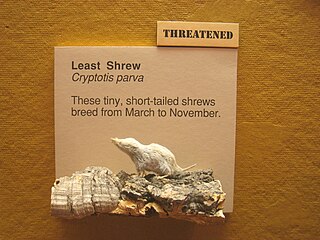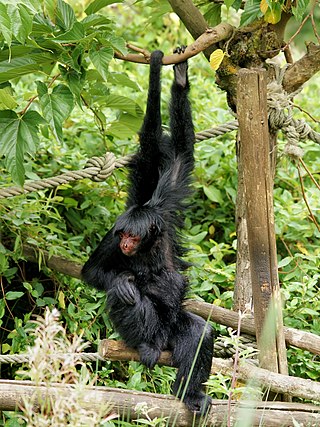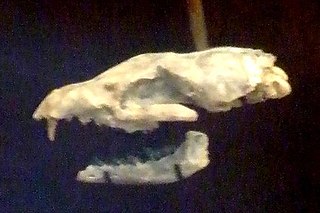
Chipmunks are small, striped rodents of the family Sciuridae. Chipmunks are found in North America, with the exception of the Siberian chipmunk which is found primarily in Asia.

The Atelidae are one of the five families of New World monkeys now recognised. It was formerly included in the family Cebidae. Atelids are generally larger monkeys; the family includes the howler, spider, woolly, and woolly spider monkeys. They are found throughout the forested regions of Central and South America, from Mexico to northern Argentina.

Spider monkeys are New World monkeys belonging to the genus Ateles, part of the subfamily Atelinae, family Atelidae. Like other atelines, they are found in tropical forests of Central and South America, from southern Mexico to Brazil. The genus consistes of seven species, all of which are under threat; the brown spider monkey is critically endangered. They are also notable for their ability to be easily bred in captivity.

The Atelinae are a subfamily of New World monkeys in the family Atelidae, and includes the various spider and woolly monkeys. The primary distinguishing feature of the atelines is their long prehensile tails, which can support their entire body weight.

The genus Cryptotis is a group of relatively small shrews with short ears, which are usually not visible, and short tails, commonly called small-eared shrews. They have 30 teeth and are members of the red-toothed shrew subfamily. Since 1992, Neal Woodman at the United States National Museum has been in the process of revising the genus. To date, this has resulted in an increase in the number of species from 12 to 30.

The white-bellied spider monkey, also known as the white-fronted or long-haired spider monkey, is an endangered species of spider monkey, a type of New World monkey. It is found in the north-western Amazon in Colombia, Ecuador, Venezuela, Peru and Brazil, ranging as far south as the lower Ucayali River and as far east as the Branco River. In the past, the Peruvian, brown and white-cheeked spider monkeys have been treated as subspecies of A. belzebuth. As presently defined, the white-bellied spider monkey is monotypic. It has a whitish belly and a pale patch on the forehead, which, despite its common name, often is orange-buff, though this might be due to dirt and other stainers. They live in groups of 20 to 40 individuals, splitting into small parties of 1 to 9 when in activity.

The red-faced spider monkey also known as the Guiana spider monkey or red-faced black spider monkey, is a species of spider monkey found in the rain forests in northern South America.

Geoffroy's spider monkey, also known as the black-handed spider monkey or the Central American spider monkey, is a species of spider monkey, a type of New World monkey, from Central America, parts of Mexico and possibly a small portion of Colombia. There are at least five subspecies. Some primatologists classify the black-headed spider monkey, found in Panama, Colombia, and Ecuador as the same species as Geoffroy's spider monkey.

The white-cheeked spider monkey is a species of spider monkey, a type of New World monkey, endemic to Brazil. It moves around the forest canopy in small family groups of two to four, part of larger groups of a few dozen animals. This monkey feeds on leaves, flowers, fruits, bark, honey and small insects, and it is an important means of seed dispersal for forest trees. Females give birth after a 230-day gestation period. The population of this monkey is decreasing as its forest habitat is lost to soybean production, deforestation and road construction. It is also regarded as a delicacy and hunted for food. For these reasons, the International Union for Conservation of Nature has assessed the animal's conservation status as being "endangered".

The Peruvian spider monkey, also known as the black-faced black spider monkey, is a species of spider monkey that lives in Peru, as well as in Brazil and in Bolivia. At 60 centimetres long, they are relatively large among species of monkey, and their strong, prehensile tails can be up to 1 m (3 ft) long. Unlike many species of monkey, they have only a vestigial thumb, an adaptation which enables them to travel using brachiation. Peruvian spider monkeys live in groups of 20–30 individuals, but these groups are rarely all together simultaneously. The size and dynamics of the resulting subgroups vary with food availability and sociobehavioral activity. They prefer to eat fleshy fruit, but will change their diet in response to scarcity of ripe fruit. Individuals of this species also eat small animals, insects and leaves based on availability. Females separate from the band to give birth, typically in the fall. These females inhabit a group of core areas where resources are abundant in certain seasons. Typically, males exhibit ranging over longer distances than females, with movement of individuals enhancing the fluidity of subgroup size. Peruvian spider monkey are independent at about 10 months, with a lifespan of about 20 years.
Isthmomys is a genus of rodent in the family Cricetidae, belonging to the tribe Reithrodontomyini. Species are:
Oligoryzomys magellanicus, also known as the Patagonian colilargo and the Magellanic pygmy rice rat, is a species of rodent in the genus Oligoryzomys of the family Cricetidae. It is found in the southernmost parts of Argentina and Chile, including Tierra del Fuego and other outlying islands. Its karyotype has 2n = 54 and FNa = 66.

Goodwin's broad-clawed shrew is a species of mammal in the shrew family, Soricidae. Body length and size of adults average 9.49 cm and 7.0 grams respectively making it a relatively larger shew. What distinguishes this from other shrews are its long claws.

Cormocyon is an extinct genus of borophagine canid native to North America. It lived from the Oligocene to the Early Miocene, 30.8—20.6 Mya, existing for about 10.2 million years. It is regarded as a primitive, transitional member of the Borophagini tribe.
The brown-headed spider monkey is a critically endangered subspecies of the black-headed spider monkey, a type of New World monkey, found in northwestern Ecuador.

The Mexican spider monkey is a subspecies of Geoffroy's spider monkey, a type of New World monkey, from Mexico and Central America, native to Mexico, Guatemala, Honduras, Nicaragua and El Salvador. It is described as being critically endangered by the IUCN, due to an 80% population decline in the last 45 years, mostly due to a large amount of habitat loss.
A unique and diverse albeit phylogenetically restricted mammal fauna is known from the Caribbean region. The region—specifically, all islands in the Caribbean Sea and the Bahamas, Turks and Caicos Islands, and Barbados, which are not in the Caribbean Sea but biogeographically belong to the same Caribbean bioregion—has been home to several families found nowhere else, but much of this diversity is now extinct.












